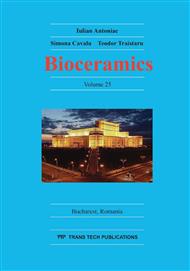[1]
M.G. Albu, Collagen Gels and Matrices for Biomedical Applications, Lambert Academic Publishing, Saarbrücken, Germany, ISBN 3844330577, (2011).
Google Scholar
[2]
S.V. Dorozhkin, Calcium orthophosphates. J Mater Sci. 42 (2007) 1061–1095.
Google Scholar
[3]
Racquel Z. LeGeros, Biological and synthetic apatites, in: Brown P.W., Constantz B., editors. Hydroxyapatite and related materials, CRC Press, Boca Raton (1994).
Google Scholar
[4]
T. Yamamuro, J. Wilson, and L.L. Hench, Handbook of bioactive ceramics: vol. II. Calcium Phosphate and hydroxylapatite ceramics, CRC Press, Boca Raton, Florida, (1990).
DOI: 10.1002/jbm.820250709
Google Scholar
[5]
K. Nezahat, A. Cuneyt, Synthesis of calcium hydroxyapatite - tricalcium phosphate (HA-TCP) composite bioceramic powders and their sintering behavior, J. Am. Ceram. Soc., 81(9) (1998) 2245-2252.
DOI: 10.1111/j.1151-2916.1998.tb02618.x
Google Scholar
[6]
M.D. Vranceanu, I. Antoniac, F. Miculescu, R. Saban, The influence of the ceramic phase on the porosity of some biocomposites with collagen matrix used as bone substitutes, Journal of Optoelectronics and Advanced Materials, Vol. 14, 7- 8 (2012).
Google Scholar
[7]
P. Sepulveda, F.S. Ortega, M.D.M. Innocentini, V.C. Pandolfelli: Properties of highly porous hydroxyapatite obtained by the gel casting of foams. Journal of the American Ceramic Society, 83 (2000) 3021–3024.
DOI: 10.1111/j.1151-2916.2000.tb01677.x
Google Scholar
[8]
C. Zou, W. Wenga, X. Dengb, K. Chenga, X. Liub, P. Dua, G. Shena, G. Hana, Preparation and characterization of porous β-tricalcium phosphate/collagen composites with an integrated structure, Biomaterials, 26 (2005) 5276-5284.
DOI: 10.1016/j.biomaterials.2005.01.064
Google Scholar
[9]
Y. Zhang, M. Zhang: Synthesis and characterization of macroporous chitosan/calcium phosphate composite scaffolds for tissue engineering. Journal of Biomedical Materials Research, 55 (2001) 304–312.
DOI: 10.1002/1097-4636(20010605)55:3<304::aid-jbm1018>3.0.co;2-j
Google Scholar
[10]
H. Bundela, A.K. Bajpai, Designing of hydroxyapatite-gelatin based porous matrix as bone substitute: Correlation with biocompatibility aspects, eXPRESS Polymer Letters, Vol. 2, No. 3 (2008) 201–213.
DOI: 10.3144/expresspolymlett.2008.25
Google Scholar
[11]
S.B. Cho, K. Nakanishi, T. Kokubo, N. Soga, C. Ohtsuki and T. Nakamura, Apatite formation on silica gel in simulated body fluid: its dependence on structures of silica gels prepared in different media, J. Biomed. Mater. Res, 33 (1995) 145-151.
DOI: 10.1002/(sici)1097-4636(199623)33:3<145::aid-jbm4>3.0.co;2-q
Google Scholar
[12]
T. Kokubo, H. Takadama, How useful is SBF in predicting in vivo bone bioactivity?, Biomaterials 27 (2006) 2907-2915.
DOI: 10.1016/j.biomaterials.2006.01.017
Google Scholar
[13]
Y. Jiao, Q. Feng, X. Li, The co-effect of collagen and magnesium ions on calcium carbonate biomineralization, Materials Science and Engineering C, Vol 26; No. 4 (2006) 648-652.
DOI: 10.1016/j.msec.2005.08.038
Google Scholar


